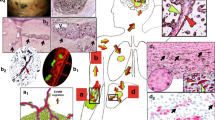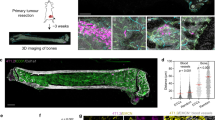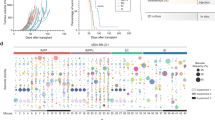Abstract
One explanation for the clinical association between tumour vascularity and probability of metastasis is that increased primary tumour vascularity enhances haematogenous dissemination by offering greater opportunity for tumour cell invasion into the circulation (intravasation). We devised an experimental tumour metastasis model that allowed manipulation of primary tumour vascularity with differential exposure of the primary and metastatic tumour site to angiogenic agents. We used this model to assess the effects of local and systemic increases in the level of the angiogenic agent basic fibroblast growth factor on metastasis. BDIX rats with implanted hind limb K12/TR adenocarcinoma tumours received either intratumoural or systemic, basic fibroblast growth factor or saline infusion. Both intratumoural and systemic basic fibroblast growth factor infusion resulted in significant increases in tumour vascularity, blood flow and growth, but not lung metastasis, compared with saline-infused controls. Raised basic fibroblast growth factor levels and increase in primary tumour vascularity did not increase metastasis. The clinical association between tumour vascularity and metastasis is most likely to arise from a metastatic tumour genotype that links increased tumour vascularity with greater metastatic potential.
This is a preview of subscription content, access via your institution
Access options
Subscribe to this journal
Receive 24 print issues and online access
$259.00 per year
only $10.79 per issue
Buy this article
- Purchase on Springer Link
- Instant access to full article PDF
Prices may be subject to local taxes which are calculated during checkout







Similar content being viewed by others
References
Aherne WA, Dunnill DM (1982) Morphometry pp 33–44, Edward Arnold
Bartsch D, Bastian D, Barth P, Schudy A, Nies C, Kisker O, Wagner HJ, Rothmund M (1998) K ras oncogene mutations indicate malignancy in cystic tumours of the pancreas. Ann Surg 228(1): 79–86
Carmichael J, DeGraff WG, Gazdar AF, Minna JD, Mitchell JB (1987) Evaluation of a tetrazolium-based semiautomated colorimetric assay: assessment of chemosensitivity testing. Cancer Res 47: 936–942
Chalkley HW (1943) Method for the quantitative morphological analysis of tissue. J Natl Cancer Inst 4: 47–53
Davies MM, Burke D, Carnochan P, Glover C, Kaur S, Allen-Mersh TG (2001) Basic fibroblast growth factor infusion increases tumour vascularity, blood flow and chemotherapy uptake. Acta Oncologica in press
Dunnington DJ, Buscarino C, Gennaro D, Greig R, Poste G (1987) Characterization of an animal model of metastatic colon cancer. Int J Cancer 39: 248–254
Ennis RD, Catz AE, De Vries GM (1997) Detection of circulating prostate carcinoma cells using an enhanced RT-PCR assay in patients with early stage prostate carcinoma. Independence from other pre-treatment characteristics. Cancer 79: 2402–2408
Euhus DM, Hudd C, La Regina MC, Johnson FE (1986) Tumour measurement in the nude mouse. J Surg Oncol 31(4): 229–234
Fidler IJ (1997) Molecular Biology of Cancer: Invasion and Metastasis. InCancer: Principles & Practice of Oncology 5th edn DeVita VT, Hellman S, Rosenberg SA (eds) pp 135–152, Philadelphia: Lippincott-Raven
Folkman J (1996) New perspectives in clinical oncology from angiogenesis research. Eur J Cancer 32A: 2534–2539
Hall PA, Levison DA, Woods AL, Yu CC-W, Kellock DB, Watkins JA, Bares DM, Gillett CE, Camplejohn R, Dover R, Waseem NH, Lane P (1990) Proliferating cell nuclear antigen (PCNA) immunolocalisation in paraffin sections: an index of cell proliferation with evidence of deregulated expression in some neoplasms. J Pathol 162: 285–294
Hemingway DM, Cooke TG, Grime SJ, Nott DM, Jenkins SA (1991) Changes in hepatic haemodynamics hepatic perfusion index during the growth and development of hypovascular sarcoma in rats. Br J Surg 78: 236–330
Hu DE, Hori Y, Presta M, Gresham GA, Fan TP (1994) Inhibition of angiogenesis in rats by IL-1 receptor antagonist and selected cytokine antibodies. Inflammation 18: 45–58
Kolber DL, Knisely TL, Maione TE (1995) Inhibition of development of murine melanoma lung metastases by systemic administration of recombinant platelet factor 4. J Natl Cancer Inst 87: 304–309
Liotta LA, Kleinerman J, Saidel GM (1974) Quantitative relationships of intravascular tumour cells, tumour vessels, and pulmonary metastases following tumour implantation. Cancer Res 34: 997–1004
Maehara Y, Kabashima A, Koga T, Tokunaga E, Takeuchi H, Kakeji Y, Sugimachi K (2000) Vascular invasion and potential for tumour angiogenesis and metastasis in gastric carcinoma. Surgery 128(3): 408–416
Mathur P, Davies MM, Burke D, Carnochan P, Allen-Mersh TG bFGF receptor expression on endothelium and tumour cells differs in experimental models. (1999) Eur J Surg Oncol 25(6): 661–662
Mathur P, Wharton RQ, Jonas SK, Saini S, Allen-Mersh TG (2001) Relationship between tumour vascularity and circulating cancer cells in patients with colorectal carcinoma. Eur J Surg Oncol 27: 354–358
Matsuyama K, Chiba Y, Sasaki M, Tanaka H, Muraoka R, Tanigawa N (1998) Tumor angiogenesis as a prognostic marker in operable non-small cell lung cancer. Ann Thorac Surg 65(5): 1405–1409
Mehta R, Kyshtoobayeva A, Kurosaki T, Small EJ, Kim H, Stroup R, McLaren CE, Li KT, Fruehauf JP (2001) Independent association of angiogenesis index with outcome in prostate cancer. Clin Cancer Res 7(1): 81–88
Montesano R, Vassalli J-D, Baird A, Guillemin R, Orci L (1986) Basic fibroblast growth factor induces angiogenesis in vitro. Proc Natl Acad Sci USA 83: 7297–7301
Mosmann T (1983) Rapid colorimetric assay for cellular growth and survival: application to proliferation and cytotoxic assays. J Immunol Methods 65: 55–63
Nanashima A, Ito M, Sekine I, Naito S, Yamguchi H, Nakagoe T, Ayabe H (1998) Significance of angiogenic factors in liver metastatic tumors originating from colorectal cancers. Dig Dis Sci 43(12): 2634–2640
Rak J, Filmus G, Finkenzeller G, Grugel S, Marma D, Kerbel RS (1995) Oncogenes as inducers of angiogenesis. Cancer Metas Rev 14: 263–277
Teixeira CR, Tanaka S, Haruma K, Yoshihara M, Sumii K, Kajiyama G (1994) Proliferating cell nuclear antigen expression at the invasive tumor margin predicts malignant potential of colorectal carcinomas. Cancer 73: 575–579
Terayama N, Terada T, Nakanuma Y (1996) An immunohistochemical study of tumour vessels in metastatic liver cancers and the surrounding liver tissue. Histopathology 29: 37–43
Tjalma W, Van Marck E, Weyler J, Dirix L, Van Daele A, Goovaerts G, Albertyn G, Van Dam P (1998) Quantification and prognostic relevance of angiogenic parameters in invasive cervical cancer. Br J Cancer 78(2): 170–174
Tozer GM, Shaffi KM (1993) Modification of tumour blood flow using the hypertensive agent. Angiotensin II 67: 981–988
Underwood EE (1970) Quantitative Stereology pp 43–44, Reading, MA: Addison-Wesley
Weidner N (1998) Tumoural vascularity as a prognostic indicator in cancer patients: the evidence continues to grow (Editorial). J Pathol 184(2): 119–122
Weidner N, Carroll PR, Flax J, Blumenfeld W, Folkman J (1993) Tumour angiogenesis correlates with metastasis in invasive prostate carcinoma. Am J Pathol 143(2): 401–409
Weidner N, Semple JP, Welch W, Folkman J (1991) Tumour angiogenesis and metastasis- correlation in invasive breast carcinoma. NEJM 324(1): 1–8
Wexler H (1966) Accurate identification of experimental pulmonary metastases. J Natl Cancer Inst 36: 641–643
Wharton RQ, Jonas SK, Glover C, Khan ZAJ, Klokoukas A, Quinn H, Henry M, Allen-Mersh TG (1999) Increased detection of circulating tumour cells in the blood of colorectal carcinoma patients using two Reverse Transcription-PCR assays and multiple blood samples. Clin Cancer Res 5: 4158–4163
Acknowledgements
MM Davies was a Stefan Galeski Research Fellow. MM Davies and P Mathur were supported by Colon Cancer Concern, London, UK. The bFGF was supplied by Amgen, California, USA and Bachem, UK. The K12/TR cells were supplied by Dr S Watson, Queens Medical Centre, Nottingham, UK and Dr S Eccles, Institute of Cancer Research, Sutton, UK; and cultured by Dr H Coley and Mr G Box, Institute of Cancer Research, Sutton, UK. We thank Clare Glover MA CStat for statistical advice.
Author information
Authors and Affiliations
Corresponding author
Rights and permissions
About this article
Cite this article
Davies, M., Mathur, P., Carnochan, P. et al. Effect of manipulation of primary tumour vascularity on metastasis in an adenocarcinoma model. Br J Cancer 86, 123–129 (2002). https://doi.org/10.1038/sj.bjc.6600020
Received:
Revised:
Accepted:
Published:
Issue Date:
DOI: https://doi.org/10.1038/sj.bjc.6600020
Keywords
This article is cited by
-
CircRUNX1 drives the malignant phenotypes of lung adenocarcinoma through mediating the miR-5195-3p/HMGB3 network
General Thoracic and Cardiovascular Surgery (2024)



